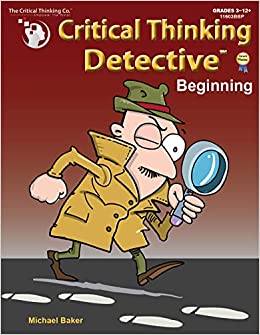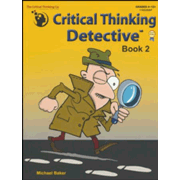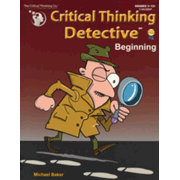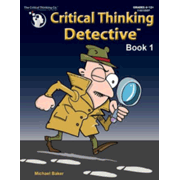The Critical Thinking Detective™ series includes books under three strands: critical thinking, math, and vocabulary. This review focuses on the critical thinking strand that consists of three books titled Critical Thinking Detective with the subtitles Beginning, Book 1, and Book 2, respectively. Beginning is for grades three through twelve, and Book 1 and Book 2 are both for grades four through twelve.
In all three books, each lesson is set up on one page showing four possible culprits for a crime or misadventure. Students need to read a few paragraphs about the situation that usually include the statements of observers and some data points. Students then read brief statements from each of the suspects to gain further information. Students have to piece together information from the various sources to eliminate the three innocent parties and identify the one that is guilty.
Students are told to assume that the facts related by a witness or suspect are true statements. However, some statements are merely opinions, and students need to distinguish between fact and opinion to weigh the value of the statements.
The lessons remind me of the logic grid puzzles where you are given various bits of information, and the grid helps you keep track of your observations and conclusions. In this case, there are no grids, and students need to keep track of information mentally or with their own notes as they deduce the correct answer.
For instance, in one scenario, a witness says that the thief was “was six feet or slightly taller…” Images of the four suspects show that two of them are clearly taller than the others. The personal statement of one of the tall suspects tells us that he is about six feet tall. This statement helps the student narrow down to two suspects. The statement of one of the tall suspects tells us that he was with two friends at the time of the incident. A witness had said that the thief was alone, so this eliminates one of the two tall suspects and leaves only the guilty party.
Students do not know immediately which pieces of information are most critical, so they have to read carefully and reread to pick up details they missed the first time around.
An activity page that faces each lesson page is used either to help solve the mystery or as a follow-up. While all of the activity pages ask students to identify the best evidence for innocence and guilt for each suspect, the activity pages in the Beginning book differ significantly from those in the other two books in ways that make them easier. In Beginning, the sentences in the lesson are numbered, and students are asked to fill in the number of the sentence that provides the best evidence. The conclusion requires students to fill in some blanks rather than compose their own sentences. And the activity page generally identifies two of the innocent suspects, requiring students to only identify the sentence that supports those conclusions. Because these activity-page features make it easier for the student to solve each mystery, you might give younger students access to the activity page in the Beginning book before they arrive at their own conclusion, but you should require older students to figure out the guilty party before they see the activity page.
The other two books also number the sentences in the lesson, but the activity pages are mostly blank forms that require students to write out their explanations in complete sentences regarding the innocence or guilt of each suspect. Students have to identify the numbers of the sentences they use as evidence.
Each book has twelve lessons, so a student could complete two or all three books in one year using one lesson per week. These books are available in print or as ebooks (in a proprietary format only for Windows systems that allows you to read and print the pages). Answer keys with full explanations are at the back of each book.
Summary
Most students (as well as adults) are likely to experience the lessons in these books as entertaining puzzles to solve. Students can use these independently or they can read and discuss them with others as they sort out the clues together.













